http://hawksites.newpaltz.edu/girlsingames/
maisie, kayla, alex
Wigmore Street, from
“The Adventure of the Blue Carbuncle”
Google Maps via London OS Town Plan 1893-1896
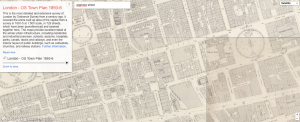
Modern View
Wigmore Street is a street in the City of Westminster, in the West End of London. The street runs for about 600 yards parallel and to the north of Oxford Street between Portman Square to the west and Cavendish Square to the east. In Victorian London, Wigmore Street was one of shops, homes, and varying socioeconomic status. For Sherlock Holmes, and John H. Watson, Wigmore Street is merley one you pass by, to get to the next one, as dictated from Sir Arthur Conan Doyles “The Adventure of the Blue Carbuncle”,
“Wimpole Street, Harley Street, and so through Wigmore Street into Oxford Street. In a quarter of an hour we were in Bloomsbury at the Alpha Inn, which is a small public-house at the corner of one of the streets which runs down into Holborn. “
On further investigation, I discovered that Wigmore Street remains largely overlooked, a mere passing street of little interest. Wigmore seems average now, in present day, and it seems that it was average in the setting of Sherlock. During the Victorian era, according to Booth Poverty Map’s, the middle class faced the street itself, while clusters of higher class would surround the blocks. Interestingly enough, small lines of blue and black even, indicated the poor and low class were close by too, impressively close to the wealthy even.
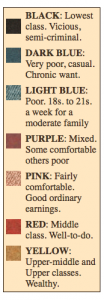
 Even with the varying levels of class, Wigmore remained somewhat stagnant and had low crime. This could be related to the police departments presence no more than a block away. However, when crime was committed it was usually theft according to court records from Old Bailey Online as well as Locating London. The theft is usually small, for example
Even with the varying levels of class, Wigmore remained somewhat stagnant and had low crime. This could be related to the police departments presence no more than a block away. However, when crime was committed it was usually theft according to court records from Old Bailey Online as well as Locating London. The theft is usually small, for example
SUSANNAH LACY was indicted for stealing, on the 27th of July , 33 yards of ribbon, value 5 s. , the goods of William Debenham and Thomas Clark .
WILLIAM DEBENHAM . I am in partnership with Thomas Clark ; we are haberdashers , and live in Wigmore-street, Cavendish-square . On the 27th of July, about two o’clock in the afternoon, Barnes called me, and said the prisoner had taken a piece of ribbon. I took her into the counting-house, and she produced it from her handkerchief.
FRANCIS BARNES . I am apprentice to the prosecutors. I saw the prisoner take the ribbon out of the drawer, and put it into her handkerchief.
(Property produced and sworn to.) Prisoner. Distress led me to it.GUILTY . Aged 44.Confined Six Months .Third Middlesex Jury, before Mr. Recorder.
She stole ribbon, and indicates that stress led her to doing so. There is no apparent drama or excitement, like I hoped, it seems on Wigmore Street. Due to it’s close proximity to Oxford Street, I looked into the London Eye website’s Oxford Street subcategory. There was not much information there. Highlighted in the British History Online, are seemingly the wills of the wealthy who died in the Victorian Era, and either had residence on Wigmore Street or investment.
Wigmore Street remains one of little interest; to Holmes, as well as historians.
Works Cited
“Booth Poverty Map & Modern Map (Charles Booth Online Archive).” Booth Poverty Map & Modern Map (Charles Booth Online Archive). N.p., n.d. Web. 06 Nov. 2015. <http://booth.lse.ac.uk/cgi-bin/do.pl?sub=view_booth_and_barth&args=528400%2C181259%2C1%2Clarge%2C0>.
“Google Maps Engine: Map View.” Google Maps Engine: Map View. N.p., n.d. Web. 06 Nov. 2015. <https://mapsengine.google.com/07550989709782409818-08328807677136535917-4/mapview/?authuser=0>.
“The Historical Eye.” London 1896. N.p., n.d. Web. 06 Nov. 2015. <http://historicaleye.com/1896%20London%20then%20and%20now/index.html>.
“Home | LOCATING LONDON’S PAST.” Home | LOCATING LONDON’S PAST. N.p., n.d. Web. 06 Nov. 2015. <http://locatinglondon.org/>.
“The Proceedings of the Old Bailey.” Old Bailey Online. N.p., n.d. Web. 06 Nov. 2015. <http://www.oldbaileyonline.org/>.
“Search.” Search. N.p., n.d. Web. 06 Nov. 2015. <http://www.british-history.ac.uk/search/period/18th-century?query=%22wigmore+street%22&title=>.
https://www.google.com/fusiontables/DataSource?docid=1jNGQNPrwU-j8oWzP-gU5fKlYIC9CWThhZDruIx29
Google Spreadsheet Info
Cards
map locations of videos
Pie graph
Bar graph
Donut graph
Maisie Miller
Online assignment #5
My Ngrams focused on words assigned to women by their male counterparts, whom mainly published these words, during the Victorian age. I choose hysteria and prostitution as my main focus because I was curious to see how the “fallen” women’s roles played against each other. I was surprised to see that they met and switched positions on the graph.
Further research into the words, described a dark time for women with mental illness, ( or misdiagnosed illness), as well as a period of time where options were limited for employment and resources. In Victorian times, a woman could be considered “unbalanced” due to a variety of causes, including: menstruation-related anger, pregnancy-related sadness, postpartum depression symptoms, disobedience, chronic fatigue syndrome, anxiety, and prostitution, among other things. Victorian society emphasized female purity and supported the ideal of the “true woman” as wife, mother, and keeper of the home. A hysterical female was one who could be nervous, eccentric, and/or exhibit erratic behaviour, the epidemiology of hysteria eluded medical explanation in the Victorian era. For hysterical women and their families, the asylum offered a convenient and socially acceptable excuse for inappropriate, and potentially scandalous behavior. Prostitution or, “fallen woman,” were usually of the lower classes, and had strayed from the idea of true womanhood by giving in to seduction and sin.

(Cartoon’s of prostitutes; http://profpoofpof.blogspot.com/2013/11/prostitution-in-victorian-times.html Women in asylum for committing the biggest sin https://victorianparis.wordpress.com/2011/10/23/degrees-of-prostitution/ )
“Hysteria” starts at the lower portion of the graph, while “prostitution” begins at a higher point on the y axis. Around 1853, “prostitution” and “hysteria” meet and finally cross each other, reversing their previous positions. “Hysteria” ends up above “prostitution” on the y axis. This could be due to a number of things, one being that the use of the word “prostitution”, was thought of as vulgar in certain levels of society, to describe women who practiced sex acts with men for money. Whereas “hysteria” developed as an widespread mania.
(Books on prostitution, notice the titles. http://www.indiana.edu/~liblilly/offthepedestal/otp5.html )
In 1864 the first of the Contagious Diseases Acts was passed. It required any allegedly diseased prostitute to undergo an inspection (the allegation may be made by an infected enlisted man). If she was found to be infected, she could be held in a Lock Hospital for up to 3 months. This was only a temporary measure, until more stringent acts could be accommodated. The Contagious Diseases Act of 1866 allowed a special police force to order women to undergo fortnightly inspections for up to a year. By 1869, the Contagious Diseases Act required prostitutes to be officially registered and to carry cards, it increased inspection stations and targeted towns from 12 to 18, and increased lock hospital incarceration to 9 months, which can largely contribute to the decline of the word use. The graph reflects this, though doesn’t perfectly add up. This could be due to an in flow of issues regarding “prostitution”, perhaps a particularly large amount of vernal diseases spread during the rise on the graph.
(Public Domain Photo taken by Jean-Martin Charcot in 1878 during his experiments using hypnosis to treat hysteria patients.)
Hysteria’s rise is evident from it’s actual evolution, and subsequent diagnosis, during the Victorian era. In the Victorian Era, doctors discouraged physical activity by women, because they believed ridiculous medical conditions would result from it. Among a range of other concerns, doctors argued that physical exertion in women might cause their organs (particularly the reproductive organs) to become dislodged and wander around the body, causing all types of problems. As The National Institutes of Health explains hysteria in the 19th century;
“Hysteria is a pathology in which dissociation appears autonomously for neurotic reasons, and in such a way as to adversely disturb the individual’s everyday life. Janet studied five hysteria’s symptoms: anaesthesia, amnesia, abulia, motor control diseases and modification of character. The reason of hysteria is in the idée fixe, that is the subconscient or subconscious. For what concerns eroticism, Janet noted that “the hysterical are, in general, not any more erotic than normal person”. Janet’s studies are very important for the early theories of Freud, Breuer and Carl Jung (1875-1961) “.
(Professor Jean-Martin Charcot demonstrates hypnosis on a “hysterical” patient. This image is in the public domain because it’s copyright has expired.)
A physician George Taylor in 1859 claimed that a quarter of all women suffered from hysteria. Hysteria was more commonly used to describe prostitutes, even. Their “struggles”, real or not, were dismissed as simply mental illness. The tragedy of women’s status and associated language can be seen in this graph. The words ascribed to women during the Victorian age hold a heavy weight of a untold story, echoing in these whispered words.
Sources:
Web, https://www.lib.uwo.ca/archives/virtualexhibits/londonasylum/docs/surgeryamonginsane.pdf
Web, http://www.bl.uk/romantics-and-victorians/articles/prostitution
Web, http://cai.ucdavis.edu/waters-sites/prostitution/FallenWomen.htm
Web. http://www.ncbi.nlm.nih.gov/pmc/articles/PMC3480686/
Images:
http://profpoofpof.blogspot.com/2013/11/prostitution-in-victorian-times.html
http://www.indiana.edu/~liblilly/offthepedestal/otp5.html
http://unhingedhistorian.blogspot.com/2013/08/the-insane-victorians-hysteria-was-real.html
The Efficent Life
Maisie Miller
Book Traces Assignment
9/30/15
The Book Traces assignment was intriguing, mysterious, and so interesting! I loved exploring the stacks of the library and even though the class had ended, I was left to explore for the following two hours. My findings were not always conclusive; however, and so I posted a variety of books on Book Traces to demonstrate marginalia.
My favorite find of marginalia for the assignment was inside a book titled “ The Efficient Life” by Luther H. Gulick, M.D., published by Doubleday, Page & Company in 1907. The book itself is health advice from a the director of physical training in the New York City Schools. It features, in its first couple of pages, images of Theodore Roosevelt in different modes of expression; as well as, a dedication to the president. My favorite chapters from this delightful book include: “The Attack on Constipation”; “Stimulants and Other Whips”, and “Pain-The Danger Signal”. Inside most chapters are underlined passages, most the text is already italicized, but further pencil markings assure significance. Whomever was leaving these traces, was in ill health for sure. The traces are throughout the book but, specially the ones shared with Book Traces, are on pages 105, 135, and 93. They are based on idea’s of health that haven’t progressed much by modern standards, which is interesting. (Pics below)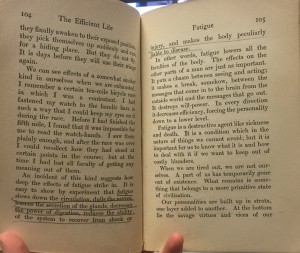
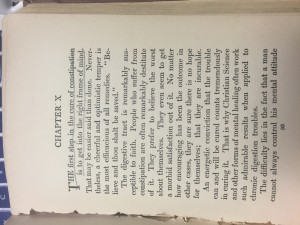
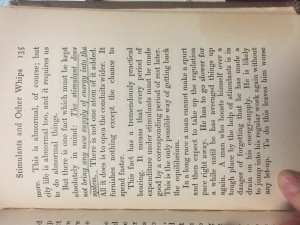

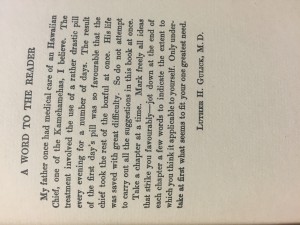

Another book with marginalia I shared with Book Traces was from “Poetical Works” by Alice and Pheobe Cary, published by Houghton, Mifflin and Company in 1882. I went directly to the poetry section of the library in hopes of finding some thoughtful notes inside. What I found in “Poetical Works”, was mostly just check marks, however, on pages 328-329, I encountered a couple favorites. Under the chapter deemed “Poems for Children”, someone has written names, check marks, alternative words and comments on the poems listed. I believe one name on 328 says “Johns” and another on page 329 “Mimi Coy”. Pursuing this lead, I tried to locate a Mimi Coy, and a John Coy, and other combinations of the name until I gave rest. There was no resolution, but the poems they love demonstrate their personalities I like to think. John loves greek heroes, as his favorite is Ajax, and Mimi Coy is perhaps being bullied in school? Without answers, there is only curiosity. (Pics Below)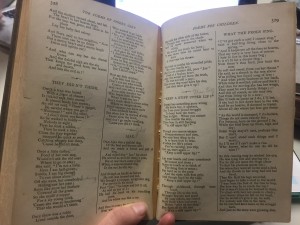
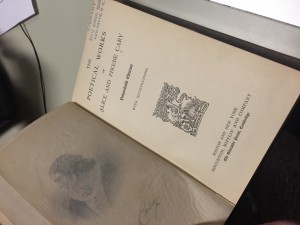
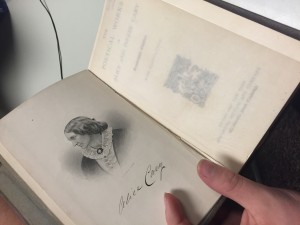

The final book I shared with Book Traces was “The Best Play’s of the Old Dramatist John Ford” written by John Ford, complied and edited by Havelock Ellis. It was published in London, in 1888. The book is old, and worn. Pages are falling apart, and it is in need of repair. I will note that in the front cover there is a illegible name as well as a address for a book seller in Oxford. I shared page 346, where inside, the word “revenge” is underlined as well as rewritten. The book is heavily marginalized with stage directions, however I found this note to be of particular peculiarity. Was this a central idea to the character? Or a central idea to the reader? It is a play, and thus I expect that this was a theme present to the character, but maybe more imagination suggests the more dramatic idea of a vengeful reader reminded of a task at hand.(Pics below)
Throughout the stacks, I picked up and put back plenty of books that were full of marginalia but fell out of the time period we were allowed to pursue. However, I cant resist sharing my favorite find of the assignment although its publishing date falls a couple year too late. “Elizabethan Verse and Prose” selected and edited by George Reuben Potter was published in 1928 by Henry Holt and Company. On the first page, Ruth Mack Havens writes that she received this book from Raymond, during Christmas of 1928. She also writes that she is from New Paltz. Throughout the 615 page book, Havens writes long notes about each poet and highlights and annotates her favorite excerpts! Fascinating opinions and connections are demonstrated throughout her notes. Its almost like reading another book entirely!(Pics below)
LINKS TO MY BOOK TRACES:
http://www.booktraces.org/book-submission-the-efficient-life/
http://www.booktraces.org/book-submission-poetical-works/
http://www.booktraces.org/book-submission-the-best-plays-of-the-old-dramatist-john-ford/
Victorian London was quite lonely for plenty of people. So lonely, that in fact, depression claimed many lives. Lee Jackson’s “Dirty Old London” website cites sections and sections of catalogued suicides. Even in a city overfilling with people, plenty were lonely and depressed. The victorian era has a lot to teach us in terms of social isolation and the impacts on the mental state of mind. In the world we currently exist in so dependent on technology it is easy to forget that the problems we now face aren’t any different than the ones we use too. A example of suicide in victorian text shared by Jackson speaks to the lonely epidemic spread throughout London, describing it as
“‘Alone in London,’ in a modified sense, is a phrase that would describe tens of thousands. The married men amongst them might, or might not, be mourned by their families, if they did not come home, or were brought home dead, at night: under similar circumstances, laundresses and landladies, and their slaveys, might pump up a tear for the bachelors, and then begin at once to provide for the next tenant of the chambers or lodgings.”(Episodes in an Obscure Life; Richard Rowe, 1871 XXI)
The lonely were expected to off themselves, in a sense. The overworked could be dead, and in a nonchalant way this was expected. The tone is present in other victorian pieces regarding suicide from Jackson’s web page. The stories are the same as they are now, evident in the example section of the webpage, where the story of a heartbroken 19 year old girl is described her grandfather in the hours before her suicide as her grandfather remembers, ” He had no knowledge of her condition. He had often heard her say of late “She wished she was out of the way,” but he did not ask why, nor did she voluntarily assign any reason for her wish.” (The Times, February 20 1890). The fear of not speaking up at the right time or making a mistake and feeling guilt through this is not observed in just victorian London, but also in a modern setting.
-Maisie Miller online assignment #1
Hi everyone! My name is Maisie Miller (twitter handle @Maisiekate).
My intended major is English with a minor in Poli-Sci, but there are so many options. I can’t quite make up my mind.
A fun fact about me is that I am a certified yoga instructor. 200 hr training & 300 hr training! 🙂
Thanks!